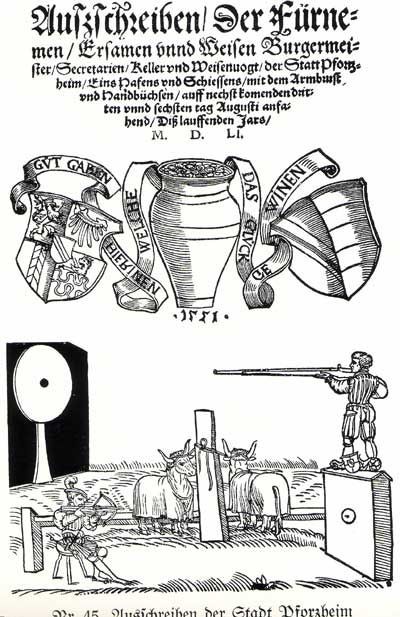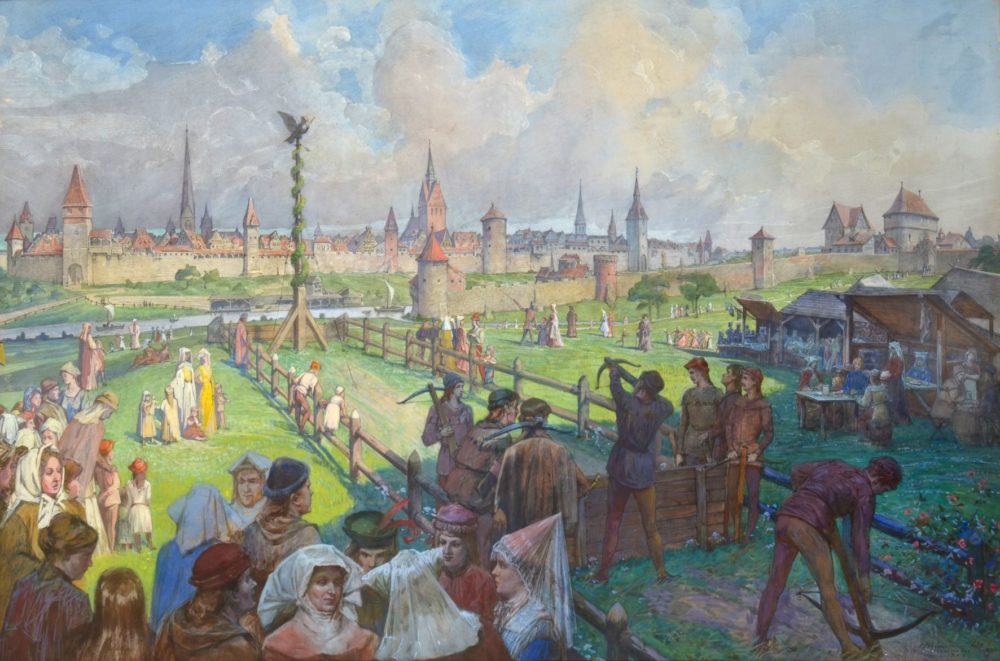
Ernst Jordan’s “Schützenfet auf Lauenrode Pfingstfestschiessen”, 1903. An early 20th Century depiction of a medieval Schützenfest, with marksmen ‘shooting the popinjay’, a special wooden target shaped like a bird. Each part of the target was designed to pop off when shot, and was worth a different amount of prize money.
So much for a summary of the basic history of medieval firearms. The next question to ask is, “So what do I do with all this?” Many people of course don’t care. But if you weren’t interested in this subject you probably already stopped reading a few pages back. Others, such as historical researchers, re-enactors and historical fencers, anyone with an interest in medieval combat or warfare, tabletop or computer gamers or game designers, authors or artists interested in the genre, and so on, may want to know what medieval firearms were really like. We seem to be culturally drawn to this era and especially to the fighting that went on.
But to do anything with it, you’ll need to be able to pin down the details a bit more. Does that then mean we must be a slave to all these details? No it doesn’t. What it means is that when you start with an accurate model of how things really worked, you can then use the bits you want and use them in such a way that they will fit into your world in a way that is fun and makes sense.
Quantifying medieval firearms
So the first step here is to quantify these things. How did they work, what were their limitations, what kind of role did they play exactly? To figure this out we have basically three tools – History, which is to say, records; artifacts and archeology, such as the guns discussed earlier; and modern experiments using recreations (usually copies of antique artifacts) or actual antiques.
Luckily the period in which firearms first became well established was a highly literate time, with a huge output of all kinds of written records. Only a small fraction of these remain to us, but that is still quite a bit, more than enough to figure this out. The archeological record is also fairly rich, with thousands of weapons surviving from the late medieval period, including at least hundreds of firearms. Finally, modern experiments, while not as ubiquitous as they could be, also provide us with some very useful information.
Shooting contests
One of the peculiar things about medieval Europe is that their approach to military training was very different from today. Our training is more like Roman training, where recruits are made to drill and told exactly how to fight according to a strict regimen of standard tactics and methods. In medieval Europe, as in many other parts of the pre-industrial world, the emphasis was much more on warlike sports and (often violent martial) games. One result of this was that their training adapted very rapidly to new weapons and tactics which were emerging on the battlefields, including firearms.
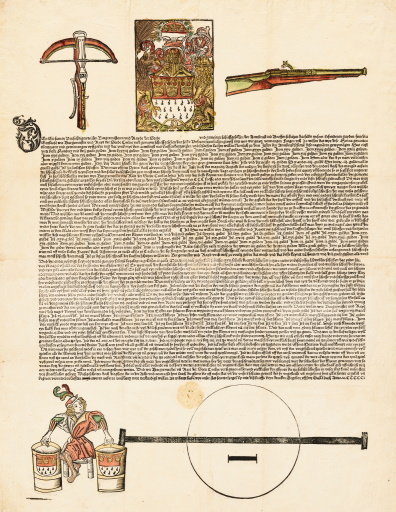
An Invitation to a shooting contest with crossbow and arquebus, 1502. The size of the target and local unit of measure are shown as a circle and a dark line. See the original here.
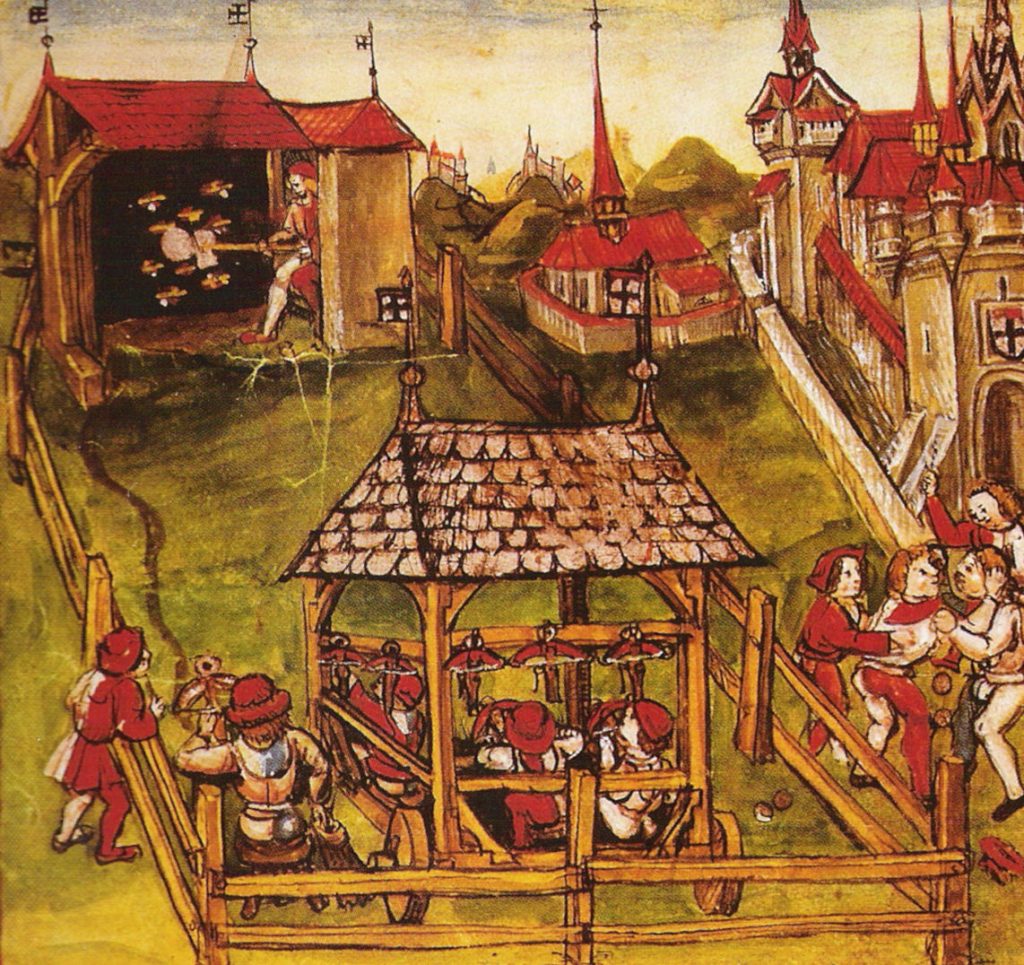
A shooting contest in the town of Konstanz in 1460, depicted in the Luzern Chronik of Diebold Schilling, circa 1472. See the original here. During this event, German and Swiss shooters got into an argument over an insult, resulting in a brawl.
That is a subject for another essay though. What is most relevant here is a specific type of warlike sport which the German speaking people called the schützenfest. These were very popular shooting contests, usually sponsored by towns in Central and Northern Europe, and Italy, which evolved into a highly competitive sport. Many became large events featuring other activities like jousting, fencing, grappling, horse racing, people racing and so on, but the shooting – with bows, crossbows, and firearms, was the main event. The best shooters could make real money, the equivalent of thousands or tens of thousands of dollars in today’s currency. These events also made money for the towns, as they attracted people from far and wide and many became major public events.
Left, shooting contest invitation from Landshut, 1549. The circle represents the size of the target, the smaller dark circle represents the size of the crossbow bolt shaft or bullet, and the dark rectangular bar represents the size of their local unit of measure. You can see the original document here. Right, shooting contest invitation from Pforzheim in 1551, showing the prizes (two oxen and a silver cup). The details were on the back.
The result of all this is that we have many records surviving from these contests. In order to ensure there was no confusion, the organizers of these events put a great deal of information on the invitations themselves. This typically included the rules, prizes, distances to the targets for different types of weapons, a physical representation of the local unit of measure and the size of the target, and the number of shots to be taken by each contestant. One invitation from Landshut in 1549 tells the reader that crossbowmen have 24 shots at the distance of 96 Landshut cubits, handgunners get 18 shots at 260 cubits. A cubit is about 18”, so this works out to roughly 144’ / 44 meters for the Crossbow, and 390’ / 118 meters for the firearms, with the target about 10” for the crossbow and 30” for the firearm. This, in turn, gives us an idea of the effective range and accuracy of these weapons at this particular time, albeit under ideal conditions.
Records and chronicles of war
Without going too far down this particular rabbit hole, we also have many detailed records, chronicles like the various illustrated Swiss Chronicles (see a good example you can page through here), and personal letters, memoirs and other accounts of warfare. These don’t always get to the level of detail we want, but sometimes they do, and there are enough of these records that looking at them in aggregate, we can get an idea of the accuracy of firearms in different time periods, and under field conditions. We also get an idea of the tactics governing their use.
Broadly speaking, we can observe the following benchmarks for firearm range from these kinds of sources.
Firearms gradually improved in range, accuracy and reliability over the medieval period. Early ‘fire lance’ and ‘hand-gonne’ types with 3-4” barrels had the range of a spear cast, no more than about 25’ / 8m or so. Longer (6-12”) barreled weapons appearing in the 14th century were hitting targets about 100’ / 30m distance or a bit more, especially when steadied over a wall or some kind of support, though still mostly in a siege context, i.e. usually within a stone’s throw of a wall of some kind.

Two short handled 15th Century ‘kolf’ handguns. These are the equivalent of carbines or sawed off shotguns, with an internal barrel length of about 12”-15”.
By the early 15th Century, what we could call the ‘early modern pattern’ emerges. We start to see firearms branching out into three main types, for short, medium and long range use, and we see two tiers of the longer-ranged firearms. One type, such as the German ‘kolf’, is a short ranged weapon which looks like a sawed off shotgun. These are in the same niche as a pistol, and were sometimes used with shot as ammunition instead of bullets. They had a limited effective range like the earliest firearms, roughly in the 20’ -50’ ballpark, but were much handier and easier to use. These were often used at the start of a fight to wound or kill an enemy before entering hand combat.

An iron barreled hacken-büsche, Czech or German in origin, with an integral hook. Caliber is 76 caliber / 19.5mm, barrel length is 31” / 79.5cm. The stock was probably added many years after the gun was forged. The barrel probably dates back to the third or fourth quarter of the 15th Century.
A second type, called a ‘hacken-büsche’ or ‘arquebus’ or any one of two dozen variants of those terms, was a medium length firearm with a 20-30” barrel, typically mounted on either a pole, or a tiller / stock like a modern firearm, and often fitted with a serpentine and typically though not always featuring a hook. The arquebus had two range bands. More poorly made weapons shot by less well trained marksmen seemed to have an effective range of about 150’ / 50 meters. A second tier of these marksmen however, often using better made weapons, could hit targets much further away, as much as 500’ / 150 meters or more.
These shooters, often people who honed their skills in the Schützenfest or while hunting, were recognized for their skill. In German armies they often received double pay as so called ‘döppelsoldners’, they were prized assets particularly in sieges. They could pick off enemy leaders, sappers, and artillery crews, and other marksmen, from an unexpectedly long distances. These same marksmen often custom tailored their firearms, loaded them with special preparations, made their own bullets and mixed their own powder. A good example of a person like this was the famous goldsmith and sculptor Benvenuto Cellini, who shot one, and possibly two enemy commanders during the siege of Rome in 1527, picking them off at ranges where they thought they were safe (and possibly unintentionally triggering the sack of Rome in the process).
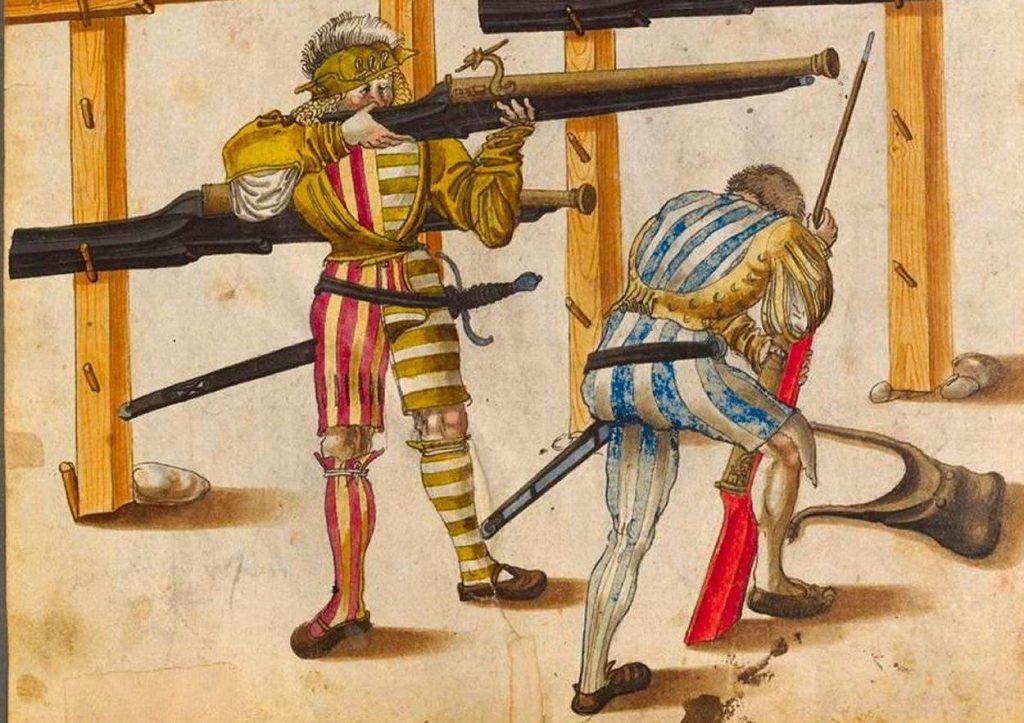
A couple of Landsknechts shooting large arquebus, probably döppelhacken or wall-guns, from the Book of Armaments of Maximilian I, 1502. You can page through the entire book here.

A huge wall-gun or doppelhacken, from Styria (Austria) early 16th Century, caliber .75” / 20mm. Weapons like this could weigh 20 kg or more, and were too heavy for infantry to carry in the open field, though they could be carried on boats or wagons. The barrel, which is older than the rest of the gun, is steel, and painted red for rust prevention.
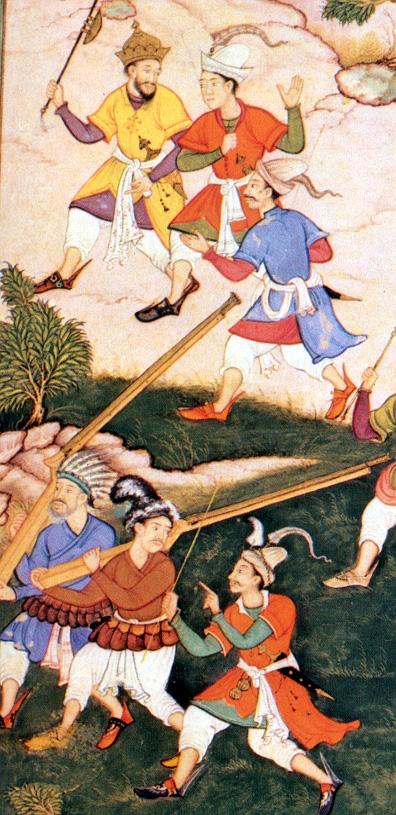
Finally, a third type of firearm emerges by the 1430s, which goes by many names. The Germans called them ‘döppelhacken’ or ‘wallbüschen’ (double guns or wall guns), the French called them arquebus a croc (which is a double reference to the hook). These were basically hand cannons, massive weapons normally used from within fortifications, and generally considered too heavy to carry around on the battlefield, but portable by wagon or carried on a boat or a raft. Due to the increasing effectiveness of armor, these longer, heavier weapons were wanted in battle. Slightly lighter, less cumbersome versions of these big guns began to be taken out into the open battlefield, relying on field fortifications or gun rests for aiming. The Italians, Portuguese and Spanish called this new beast by variations of the French word Mousquet (Mosquetto, Moschetti), or ‘little fly’. In English it was called a Musket. The Ottomans invented a similar weapon around the same time they called tüfek.
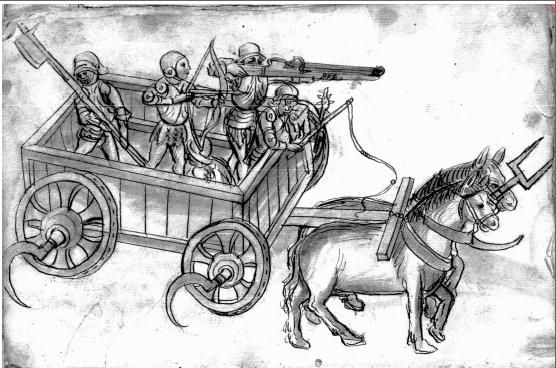
Militia from the town of Tabor (Bohemia) in a war-wagon with scythes on the wheels, one of them is wielding a huge döppelhacken type firearm. Image from the mid-15th Century
Compared to modern firearms, these early muskets are huge, (barrel length could be 60” / 5 ft / 150 cm). They are lighter than döppelhacken but still in the range of 8-12 kilos, nothing like the much lighter types used in the 18th or 19th Century, and somewhat similar to a crew-served weapon in the modern military. They had enormous recoil and could not be shot effectively without some kind of support, either the usual wall, gunwale of a ship etc., or a fork shaped pole typically carried by musketeers in the 16th-17th Centuries. Depending on the caliber and some other factors, in the hands of an expert marksman these weapons could also have a superior effective range, as much as 1,000 ft / 300 meters.


A magnificent double barreled wheellock pistol made for Emperor Charles V, made by master watchmaker Peter Peck, circa 1540. Note the two triggers and two-spring wheels. See more here.
Finally, around the turn of the 16th Century we see two more types of firearms emerge. The invention of the wheel-lock by clockmakers in Nuremberg around 1500 allowed for the creation of a weapon which could easily be handled in one hand, and thus on horseback. This was the birth of the cavalry pistol. Range was short, not much more than that of a lance, but they had some armor-piercing ability and many could be carried on the saddle (some riders carried up to six!). Nor did they require a direct horseback charge to be used effectively. You could easily kill with these things while riding in parallel lines… These guns quickly became very popular with heavy cavalry, particularly in Northern Europe, where a new class of cavalry emerged in the early 16th Century – the Schwarze Ritter, the black rider.
A new type of lighter, more accurate arquebus also emerged, based on the revealed virtues of the culverin or serpentine type of field cannon, i.e. with a longer barrel but a smaller projectile, the goal being higher velocity. These went by many names but the term klover was used in Low-German speaking areas and the similar caliver became commonplace in English sources by the late 16th Century. Both terms are probably a corruption of culverin. These weapons were similar to the arquebus, but more accurate and had an effective range equivalent to the best musket, or better.

Graz tests from the 1980s
Among our data sources, we also have modern tests, but quite often these are conducted in a haphazard fashion, or they use cheap replicas instead of (rare and expensive) antiques. But there are exceptions to this rule, and in particular, there was one legendary series of tests done in 1988 and 89 by a group consisting of an Austrian museum curator, an Austrian Army Officer, and a Canadian academic. This test was done with antiques, it was done systematically and it was recorded for posterity. The results are extremely useful.
For example, during the test a döppelhacken from Styria (Austria), made in 1571, achieved a muzzle velocity of 482 m/s, which is considerably more than a modern Glock 9mm pistol, but the döppelhacken was also shooting a huge 20mm projectile weighing 38 grams, vs 8 grams for the Glock. This works out to an astonishing 4,414 Joules for the wall gun! vs. 518 for the modern pistol. An even larger wall gun gave an incredible 6,980 Joules. This is twice the energy of a modern 7.62 mm FN FAL type assault rifle (3373 Joules) and almost four times the energy of a 5.56mm assault rifle (1764 Joules).
The energy of the old smoothbore weapons falls off much more quickly though. At 100m, the velocity of the first döppelhacken is down to 305 m/s and the energy is down to 1700 J (down to 63% of the original power) whereas for the assault rifles velocity has only declined to 770 m/s (77%) and 874 m/s (88%) respectively.
Even better, this test tells us how good the penetration of the bullet was against a variety of targets (steel and wood) at different distances, and even the size of wound channels they made. This is an excellent measure of both killing power and armor penetration. They also give us hit percentages, and here is where the modern weapons really show up well. The first döppelhacken, shooting lead balls, only hits a man-sized target 50% of the time at 100m, whereas the modern assault rifles, shooting rifled, copper jacketed bullets, hit targets at that range 100% of the time, as you would expect, and even the Glock hit targets at 30 meters 99% of the time.
Interestingly though a couple of the old smoothbore weapons also did fairly well, and in particular one wheellock pistol hit 85% of the time and another flintlock pistol hit 99% of the time. This is a bit of a mystery because smoothbore weapons aren’t really supposed to be that accurate. There was also a really interesting armor piercing test with an antique pistol. They shot an antique steel plate, (a piece of horse armor from the 16th Century, with 2.8mm thick steel), using an antique pistol at a distance of 8.5 meters. The bullet penetrated the steel armor, but got stuck in the linen padding underneath, energy spent, and did not make it through to the sandbag below that. They then shot the same gun at a 3mm piece of modern rolled steel, and it went right through and into the sandbag. This tells us that the 16th Century armor had superior ballistic properties to the modern steel plate.
Two other interesting facts. The test implies that firearm accuracy remained basically the same from the 16th Century through the 18th, which tells us that firearm design hit an early peak around 1550 (or earlier) and pretty much stayed there for a long time. It’s also noteworthy that the modern Glock 9mm only managed 2mm of penetration against the steel targets. That means that most medieval plate armor would protect you from a modern 9mm pistol. You can read all about the Graz tests here.
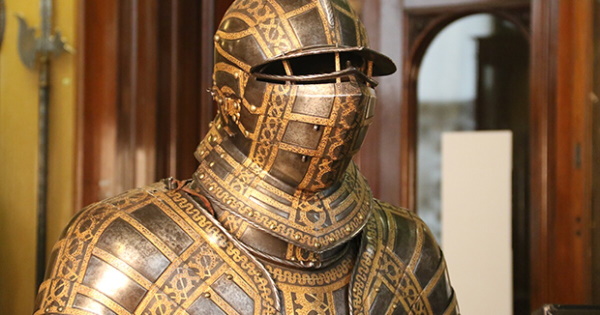
Secrets of the Shining Knight
Another much more recent test also had some rather astonishing results as relates to armor. In 2017 the documentary series NOVA arranged a very special experiment with armor. They collected some legit experts from around the world, and set two men to making a breast plate of armor based on a princely antique piece of extremely high quality made by German armorers working at the Greenwich armory in England in the 16th Century. The new armor was made exactly in the manner as the original, down to panning the iron ore and smelting the iron themselves. Once this beautiful piece was forged, tempered, and nicely decorated, they set it up on a stand, and then shot it with a heavy musket from almost point blank range.
To the evident surprise of everyone present, including Dr. Alan Williams, (author of the very highly regarded 2003 book, The Knight and the Blast Furnace, and probably the foremost expert on pre-industrial body armor in the world), the musket ball bounced off! This is something you really have to see to appreciate. You can watch the show on Amazon, or via PBS here. You can see the moment they shot the breast plate on FB here. This tells us that as effective as early firearms were, these people also made at least some armor which was even more effective.


